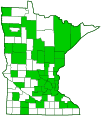Colorado potato beetle
(Leptinotarsa decemlineata)
Conservation • Description • Habitat • Ecology • Distribution • Taxonomy
Conservation Status |
|
|||||||
| IUCN Red List | not listed |
|||||||
| NatureServe | NR - Unranked |
|||||||
| Minnesota | not listed |
|||||||
Description |
||
Colorado potato beetle is relatively small for a beetle but relatively large for a leaf beetle. It is a serious crop pest to potato growers. The insect rapidly evolves resistance to chemical pesticides. Many insecticides that once successfully controlled the beetle are no longer effective. Adults are broad-bodied, ¼″ to 7 ⁄16″ long, and about ⅛″ wide. The body is oval when viewed from above (dorsally) and strongly convex when viewed from the side (laterally). The hardened plate on the upper side of the thorax (pronotum) is orangish-yellow to yellowish-brown and three times as wide as long, nearly as wide as the base of the hardened forewings (elytra). The are two black longitudinal marks in the middle that often join to form a v-shape, and several smaller black spots on each side. The elytra are long and cover the tip of the abdomen. They are pale yellow with a black inner margin and five black longitudinal lines on each side. The small triangular plate at the base of the elytra (scutellum) is black. The head is yellowish-brown with a small triangular black mark in the middle. It is partially visible when viewed from above. The antennae are short, less than half as long as the body, and widely separated at the base. They are weakly clubbed (clavate), gradually enlarged as they approach the tip. The eyes are black and are not notched. The legs are mostly yellowish-brown. The last part of each leg (tarsus), corresponding to the foot, is black and has five segments. The fourth segment is very short and is concealed within the broadened tip of the third segment, making the tarsus appear to have only four segments. The larva is very plump, strongly convex, and brick red when young, becoming pink and finally orange as it ages. It is about ½″ long when mature. It has two rows of black spots on each side, a black head, and six black legs. |
||
Size |
||
Total length: ¼″ to 7 ⁄16″ |
||
Similar Species |
||
No similar species in Minnesota |
||
Habitat |
||
Open grasslands, agricultural fields |
||
Ecology |
||
Season |
||
Two overlapping generations: May to the end of the host plants growing season |
||
Behavior |
||
|
||
Life Cycle |
||
The female deposits masses of usually 20 to 60 bright orange eggs on the lower surface of leaves of host plants. After hatching the larvae pass through five distinct stages (instars). Mature larvae burrow ¾″ to 2″ into the soil to pupate. Adults of the second generation burrow shallowly into the soil to overwinter. |
||
Larva Food |
||
Larvae are found on the same species that adults feed on. |
||
Adult Food |
||
Leaves of mostly potato but also other plants in the Solanum genus. |
||
Distribution |
||||
|
Sources Prior to European settlement the Colorado potato beetle was found only in Colorado and neighboring states. The potato was introduced into North America in the 1600s and began to be widely grown in the early 1700s. By 1840 the potato reached the insects home range. By 1859 the insect had switched to the potato as its preferred host, and by 1874 it had spread all the way to the east coast. It is now present across North America, Europe, and Asia. |
|||
| 7/4/2023 | ||||
Occurrence |
||||
Common and very widely distributed |
||||
Taxonomy |
|||
Order |
Coleoptera (Beetles) | ||
Suborder |
Polyphaga (Water, Rove, Scarab, Long-horned, Leaf, and Snout Beetles) | ||
Infraorder |
Cucujiformia | ||
Superfamily |
Chrysomeloidea (leaf beetles and allies) | ||
Family |
Chrysomelidae (leaf beetles) | ||
Subfamily |
Chrysomelinae (broad-bodied leaf beetles) | ||
Tribe |
Doryphorini | ||
| Subtribe | Doryphorina | ||
Genus |
Leptinotarsa (potato beetles) | ||
Synonyms |
|||
|
|||
Common Names |
|||
Colorado beetle Colorado potato beetle potato bug ten-lined potato beetle ten-striped spearman |
|||
Glossary
Elytra
The hardened or leathery forewings of beetles used to protect the fragile hindwings, which are used for flying. Singular: elytron.
Instar
The developmental stage of arthropods between each molt; in insects, the developmental stage of the larvae or nymph.
Pronotum
The exoskeletal plate on the upper side of the first segment of the thorax of an insect.
Scutellum
The exoskeletal plate covering the rearward (posterior) part of the middle segment of the thorax in some insects. In Coleoptera, Hemiptera, and Homoptera, the dorsal, often triangular plate behind the pronotum and between the bases of the front wings. In Diptera, the exoskeletal plate between the abdomen and the thorax.
Tarsus
On insects, the last two to five subdivisions of the leg, attached to the tibia; the foot. On spiders, the last segment of the leg. Plural: tarsi.
Visitor Photos |
|||||
Share your photo of this insect. |
|||||
| This button not working for you? Simply email us at info@MinnesotaSeasons.com. Attach one or more photos and, if you like, a caption. |
|||||
Katie Hall |
|||||
Crawling on the exterior of our living room window. Left before we could capture. |
|||||
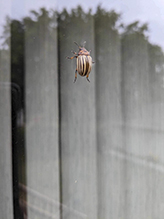 |
|||||
Ashlee French |
|||||
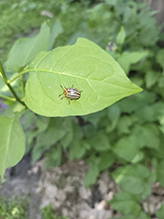 |
|||||
Dave Rodestrom |
|||||
landed on my deck |
|||||
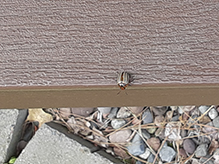 |
|||||
Amanda Ferris |
|||||
How can we control this pest safely? |
|||||
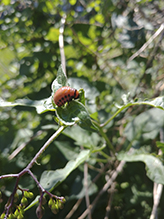 |
 |
||||
Alfredo Colon |
|||||
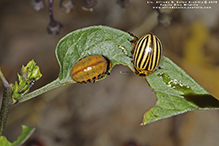 |
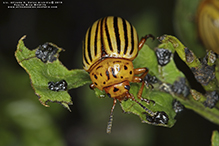 |
||||
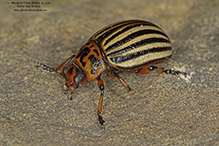 |
 |
||||
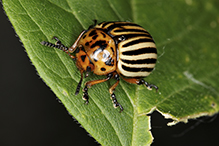 |
|||||
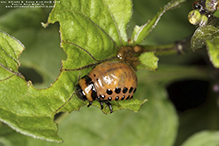 |
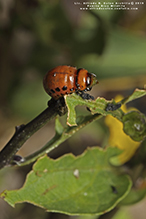 |
||||
MinnesotaSeasons.com Photos |
|||||
|
|||||

Slideshows |
||
| Colorado Potato Beetle (Leptinotarsa decemlineata) Andree Reno Sanborn |
||
 |
||
| Colorado Potato Beetle Dave Beaudette |
||
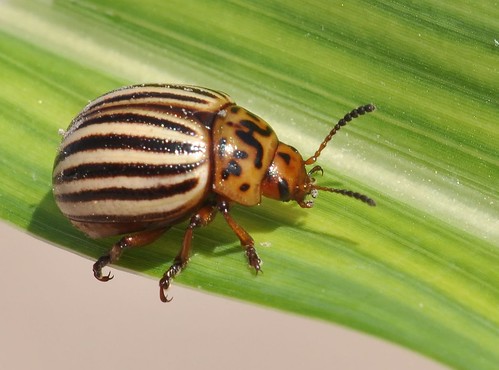 |
||
About
Leptinotarsa decemlineata |
||

Visitor Videos |
|||
Share your video of this insect. |
|||
| This button not working for you? Simply email us at info@MinnesotaSeasons.com. Attach a video, a YouTube link, or a cloud storage link. |
|||
Other Videos |
|||
| Everything you need to know about the Colorado Potato Beetle Bonnie Bucqueroux |
|||
About
Published on Jun 13, 2013 When Bonnie Bucqueroux found a hard-shelled, humpback striped beetle munching its way through her potato patch, she went on a mission to learn all she could about options for controlling this pest. You can benefit from her research. |
|||
| Kartoffelkäfer (Leptinotarsa decemlineata) Colorado potato beetle Macro Movies Chrigu wälti |
|||
About
Published on Sep 2, 2012 Kartoffelkäfer (Leptinotarsa decemlineata) Colorado beetle Macro movie vom Schädling. http://www.Insektenlexikon.ch |
|||
| Colorado Potato Beetle Carl Barrentine |
|||
About
Published on Jul 3, 2017 This short film introduces the Colorado Potato Beetle (Leptinotarsa decemlineata). Filmed at Grand Forks, North Dakota (03 July 2017). |
|||
| Colorado Potato Beetle (Chrysomelidae: Leptinotarsa decemlineata) Carl Barrentine |
|||
About
Published on Jul 18, 2009 According to Eric Eaton and Kenn Kaufman, in their book 'Field Guide to Insects of North America,' this species "is native to Mexico, where it originally fed on burweed. As cattle were grazed further north, they spead burweed and the beetles followed, reaching Colorado about 1822. Previously, Pizarro had found the Incas cultivationg potatoes in South America and had shipped some to Spain. From there the crop made it to England and on to the states. Beetle and potato met in the midwest, the insect developing a preference for this new foodplant" (p. 160). Photographed at Grand Forks, North Dakota (18 July 2009). |
|||
| Colorado potato beetle larva feeding Bug of the Week |
|||
About
Published on Jan 30, 2013 A Colorado potato beetle larva prefers potato leaves for its dinner, but may feed on a number of other plants in the family Solanacae. |
|||

Visitor Sightings |
|||||
Report a sighting of this insect. |
|||||
| This button not working for you? Simply email us at info@MinnesotaSeasons.com. Be sure to include a location. |
|||||
| Katie Hall 7/4/2023 |
Location: 6405 296th St. E., Cannon Falls, MN 55009 Crawling on the exterior of our living room window. Left before we could capture. |
 |
|||
| Ashlee French 7/18/2021 |
Location: Hutchinson MN (Mcleod Co.) |
 |
|||
| Dave Rodestrom 7/1/2020 |
Location: Sturgeon Lake in Pine County landed on my deck |
 |
|||
| Amanda Ferris 6/21/2020 |
Location: Farmington MN How can we control this pest safely? |
 |
|||
| John valo 6/22/2020 |
For methods to control this insect in a garden without chemical pesticides, you can find some recommendations at The Spruce. Here is the link: How to Get Rid of Colorado Potato Beetle Infestations Organically |
||||
| Alfredo Colon 8/2 - 9/5/2019 |
Location: Woodbury, Minnesota |
 |
|||
| Alfredo Colon 7/12/2018 |
Location: Woodbury, Minnesota |
 |
|||
| Alfredo Colon 6/5/2018 |
Location: Woodbury, Minnesota |
 |
|||
MinnesotaSeasons.com Sightings |
|||||
|
|||||

Last Updated:
